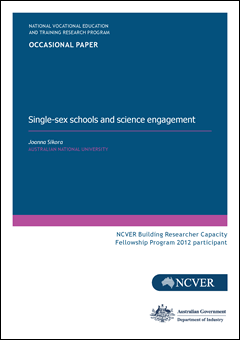Description
This paper considers whether single-sex schooling affects gendered patterns in the uptake of science courses in year 11 and the development of science-related career paths. In particular, the author is interested in exploring gender differences surrounding the life and physical sciences. The author explores these issues using data from the Longitudinal Surveys of Australian Youth. Differences in the uptake of life and physical science subjects by males and females occur across all schools. In girls-only schools girls are more likely to undertake physical science subjects than their female counterparts in co-educational schools, but there is no difference when it comes to planning a physical science career. On the other hand, boys in boys-only schools are no more likely to take up life science subjects than their male counterparts in co-educational schools, but they are more likely to plan life science careers. This research was funded through the NCVER Fellowship program.
Summary
About the research
This paper considers whether single-sex schooling affects gendered patterns in the uptake of science courses in Year 11 and the development of science-related career paths. In particular, the author is interested in exploring gender differences relating to the take-up of the life and physical sciences. To investigate these issues, the author analyses data from the 2009 cohort of the Longitudinal Surveys of Australian Youth (LSAY).
This research was funded through the National Centre for Vocational Education Research (NCVER) fellowship program, which encourages researchers to use NCVER datasets to improve our understanding of education. A second paper is further investigating gender segregation in youth science engagement by looking at gendered pathways into post-secondary science study.
Key messages
- Across all schools, male and female students systematically select different science subjects and prefer careers in different fields of science, as did their counterparts ten years ago.
- With respect to science subjects, students' gender, science performance and science self-confidence levels have a consistent positive influence on both life and physical science engagement. The latter two are more prominent in the take-up of physical science subjects.
- Single-sex schooling does not affect the likelihood of boys taking up physical or life science subjects while at school. However, boys from boys-only schools are more likely to plan a life science career, such as physiotherapy and medicine, than their male counterparts in coeducational schools.
- Girls in girls-only schools are more likely to take up physical science subjects than their female counterparts in coeducational schools. However, single-sex schooling does not affect the likelihood of girls planning a physical science career.
After controlling for a number of student and school characteristics, the author concludes that, although some benefits of sex-segregated schooling exist, the overall effects are small. Moreover, it is unlikely that these effects have a lasting impact on young people's educational and career pathways later in life, which questions whether programs designed to extend single-sex schooling into the government sector should be introduced.
Rod Camm
Managing Director, NCVER
